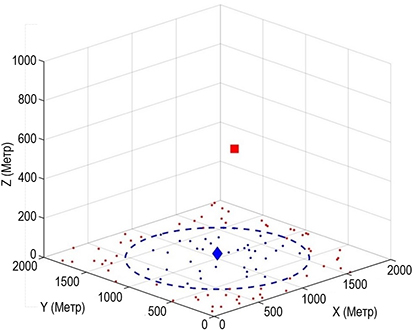
User Association, Power Allocation, and Aerial Base Stations Placement in Hybrid Networks: A Deep Reinforcement Learning Approach
https://doi.org/10.31854/1813-324X-2025-11-2-32-40
EDN: CTTRGR
Abstract
Relevance. With the development of information technologies and the Internet of Things, the demand for more efficient and flexible mobile networks is increasing. Future wireless systems must not only ensure high speed and reliability of connections but also enable quick recovery of communication in emergency situations. Ground base stations (GBS) are typically installed stationary and are designed for long-term service, which limits their efficiency during sudden increases in traffic or infrastructure damage. In such conditions, aerial base station (ABS) emerge as a promising solution. Due to their mobility, affordability, and the ability to deploy quickly, they can support the operation of ground stations in high user density conditions or in emergencies when GBS are damaged or destroyed. This makes them an essential element of future communication networks.
Problem Statement. Development of methods for the placement of ABS in three-dimensional space and the distribution of users and power among users with the goal of maximizing the data transmission speed of the systems.
Goal of the work. Increase the data transmission speed of systems using ABS to support GBS through optimal three-dimensional positioning of ABS, distribution of users between ABS and GBS, and power allocation among users.
Methods. The research was conducted using a dynamic approach, in which the coverage radius of the GBS is gradually reduced, along with the reinforcement learning algorithm. The analysis of the results showed the high effectiveness of the proposed method and allowed for a significant increase in data transmission speed within the framework of the task.
Scientific novelty. The scientific novelty of the proposed solution lies in the joint optimization of the placement of ABS and power allocation under resource constraints, which revealed a dependency between the coverage radius of GBS and the flight altitude of ABS. Specifically, as the coverage radius of GBS increases, the optimal flight altitude of ABS decreases, and vice versa.
Practical significance. The practical significance lies in the possibility of developing a methodology for planning public communication networks using ABS to support GBS under resource constraints. This approach makes it possible to ensure a high total data transmission rate and improve the reliability of network operation.
About the Authors
T.D. TranRussian Federation
A. E. Koucheryavy
Russian Federation
References
1. Tran T.D., Koucheryavy A.E. Resource Optimization of Airborne Base Stations Using Artificial Intelligence Methods. Proceedings of Telecommunication Universities. 2025;11(1):62‒68. (in Russ.) DOI:10.31854/1813-324X-2025-11-1-62-68. EDN:RVENVC
2. Kuznetsov K.A., Paramonov A.I., Muthanna A.S.A., Koucheryavy A.E. Model and Methods of Traffic Routing in a Communication Network Using UAVs. Proceedings of Telecommunication Universities. 2024;10(4):62‒72. (in Russ.) DOI:10.31854/1813-324X-2024-10-4-62-72. EDN:VYMCTD
3. Dunaitsev R.A., Borodin A.S., Koucheryavy A.E. Space-Air-Ground-Sea Integrated Networking as a Basis For 6G Networks. Electrosvyaz. 2022;10:5‒8. (in Russ.) DOI:10.34832/ELSV2022.35.10.001. EDN:QCGIPI
4. Koucheryavy A., Paramonov A., Makolkina A., Muthanna A. S. A., Vybornova A., Dunaytsev R., et al. 3 Dimension Multilayer Heterogenous Ultra Dense Networks. Telecom IT. 2022:10(3):1–12. (in Russ.) DOI:10.31854/2307-1303-2021-10-3-1-12. EDN:LHLYEM
5. Mozaffari M., Saad W., Bennis M., Debbah M. Unmanned Aerial Vehicle With Underlaid Device-to-Device Communications: Performance and Tradeoffs. IEEE Transactions on Wireless Communications. 2016;15(6):3949–3963. DOI:10.1109/TWC.2016.2531652
6. Ali M.A., Jamalipour A. UAV placement and power allocation in uplink and downlink operations of cellular network. IEEE Transactions on Communications. 2020;68(7):4383‒4393. DOI:10.1109/TCOMM.2020.2983671. EDN:MEPFGQ
7. 3GPP TR 38.901. Study on channel model for frequencies from 0.5 to 100 GHz. 2018. URL: https://portal.3gpp.org/desktopmodules/Specifications/SpecificationDetails.aspx?specificationId=3173 [Accessed 26.02.2025]
8. Shannon C.E. A Mathematical Theory of Communication. The Bell System Technical Journal. 1948;27(3):379–423. DOI:10.1002/j.1538-7305.1948.tb01338.x
9. Liu C.H., Chen Z., Tang J., Xu J., Piao C. Energy-Efficient UAV Control for Effective and Fair Communication Coverage: A Deep Reinforcement Learning Approach. IEEE Journal on Selected Areas in Communications. 2018;36(9):2059–2070. DOI:10.1109/JSAC.2018.2864373.
10. Seid A.M., Boateng G.O., Anokye S., Kwantwi T., Sun G., Liu G. Collaborative Computation Offloading and Resource Allocation in Multi-UAV-Assisted IoT Networks: A Deep Reinforcement Learning Approach. IEEE Internet of Things Journal. 2021;8(15):12203‒12218. DOI:10.1109/JIOT.2021.3063188
11. Mnih V., Kavukcuoglu K., Silver D., Rusu A.A., Veness J., Bellemare M.G., et al. Hassabis D. Human-level control through deep reinforcement learning. Nature. 2015;518:529‒533. DOI:10.1038/nature14236
12. Lillicrap T.P., Hunt J.J., Pritzel A., Heess N., Erez T., Tassa Y., et al. Continuous control with deep reinforcement learning. arXiv preprint arXiv:1509.02971. 2015. DOI:10.48550/arXiv.1509.02971
Review
For citations:
Tran T., Koucheryavy A.E. User Association, Power Allocation, and Aerial Base Stations Placement in Hybrid Networks: A Deep Reinforcement Learning Approach. Proceedings of Telecommunication Universities. 2025;11(2):32-40. (In Russ.) https://doi.org/10.31854/1813-324X-2025-11-2-32-40. EDN: CTTRGR


































